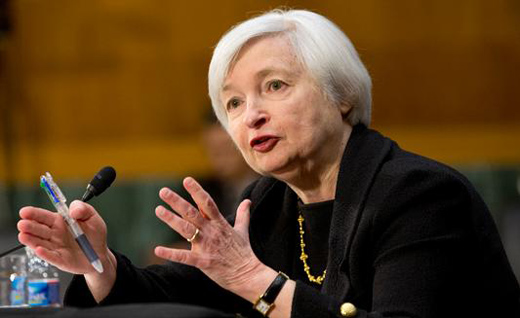
BOSTON – Even the head of the Fed now worries about the chasm of income inequality. But Janet Yellen, in a speech at the Federal Reserve Bank of Boston, took it one step beyond money. She criticized the concentration of riches at the top, too.
Her blunt words on Oct. 20 should make the rest of the country – even the financiers who created and perpetuated the gap between the rich and the rest of us – take notice.
Yellen’s speech is important because the Fed’s monetary policy regulates credit firms need to expand and, if they choose to do so, hire more workers. With the gridlocked Congress refusing to help workers, the Fed has had to be a primary engine of restoring the economy ever since the Great Recession, also known as the Bush Crash, hit.
The Fed eased credit, but wealth and income stayed at the top, charts Yellen presented show. “The past several decades have seen the most sustained rise in inequality since the 19th century after more than 40 years of narrowing inequality following the Great Depression,” she said. The Fed also has a second, often-forgotten, goal, of increasing employment.
“By some estimates, income and wealth inequality are near their highest levels in the past 100 years, much higher than the average during that time and probably higher than for much of American history before then,” Yellen said.
“It is no secret the past few decades of widening inequality can be summed up as signi-ficant income and wealth gains for those at the very top and stagnant living standards for the majority. I think it is appropriate to ask whether this is compatible with values rooted in our history, among them the high value Americans traditionally placed on equality of opportunity.”
Yellen did not answer that values question. But Yellen – who has spoken out against the gap between the rich and the rest of us since at least 2006 – offered several reasons for the growing chasm. They include a crash in housing wealth, concentrated inheritances and unequal educational opportunities due to lower revenue available to schools in lower-income areas that need the most help. She did not mention private-sector deunionization.
The wealth gap is even worse, she said. “Wealth inequality has increased more than income inequality since 1989…The wealthiest 5 percent of households held 54 percent of all wealth reported in the 1989 survey. Their share rose to 61 percent in 2010 and reached 63 percent in 2013.
“The lower half of households by wealth held just 3 percent of wealth in 1989 and only 1 percent in 2013. To put that in perspective…the average net worth of the lower half of the distribution, representing 62 million households, was $11,000 in 2013. About one-fourth of these families reported zero wealth or negative net worth, and a significant fraction said they were ‘underwater’ on their home mortgages, owing more than the value of the home.
“This $11,000 average is 50 percent lower than the average wealth of the lower half of families in 1989, adjusted for inflation,” she said. Due to housing, it has yet to recover.
Photo: Janet Yellen. Jacquelyn Martin/AP












Comments